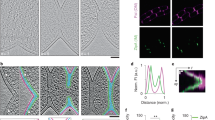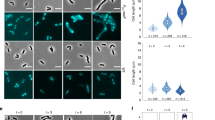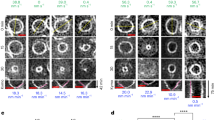Abstract
Eukaryotic-like serine/threonine kinases (eSTKs) with extracellular PASTA repeats are key membrane regulators of bacterial cell division. How PASTA repeats govern eSTK activation and function remains elusive. Using evolution- and structural-guided approaches combined with cell imaging, we disentangle the role of each PASTA repeat of the eSTK StkP from Streptococcus pneumoniae. While the three membrane-proximal PASTA repeats behave as interchangeable modules required for the activation of StkP independently of cell wall binding, they also control the septal cell wall thickness. In contrast, the fourth and membrane-distal PASTA repeat directs StkP localization at the division septum and encompasses a specific motif that is critical for final cell separation through interaction with the cell wall hydrolase LytB. We propose a model in which the extracellular four-PASTA domain of StkP plays a dual function in interconnecting the phosphorylation of StkP endogenous targets along with septal cell wall remodelling to allow cell division of the pneumococcus.
This is a preview of subscription content, access via your institution
Access options
Access Nature and 54 other Nature Portfolio journals
Get Nature+, our best-value online-access subscription
$29.99 / 30 days
cancel any time
Subscribe to this journal
Receive 12 digital issues and online access to articles
$119.00 per year
only $9.92 per issue
Buy this article
- Purchase on Springer Link
- Instant access to full article PDF
Prices may be subject to local taxes which are calculated during checkout






Similar content being viewed by others
References
Dworkin, J. Ser/Thr phosphorylation as a regulatory mechanism in bacteria. Curr. Opin. Microbiol. 24, 47–52 (2015).
Mijakovic, I., Grangeasse, C. & Turgay, K. Exploring the diversity of protein modifications: special bacterial phosphorylation systems. FEMS Microbiol. Rev. 40, 398–417 (2016).
Manuse, S., Fleurie, A., Zucchini, L., Lesterlin, C. & Grangeasse, C. Role of eukaryotic-like serine/threonine kinases in bacterial cell division and morphogenesis. FEMS Microbiol. Rev. 40, 41–56 (2016).
Pereira, S. F., Goss, L. & Dworkin, J. Eukaryote-like serine/threonine kinases and phosphatases in bacteria. Microbiol. Mol. Biol. Rev. 75, 192–212 (2011).
Yeats, C., Finn, R. D. & Bateman, A. The PASTA domain: a beta-lactam-binding domain. Trends Biochem. Sci. 27, 438 (2002).
Calvanese, L., Falcigno, L., Squeglia, F., D Auria G. & Berisio, R. PASTA in penicillin binding proteins and serine/threonine kinases: a recipe of structural, dynamic and binding properties. Curr. Med. Chem. https://doi.org/10.2174/0929867324666170216112746 (2017).
Barthe, P., Mukamolova, G. V., Roumestand, C. & Cohen-Gonsaud, M. The structure of PknB extracellular PASTA domain from Mycobacterium tuberculosis suggests a ligand-dependent kinase activation. Structure 18, 606–615 (2010).
Maestro, B. et al. Recognition of peptidoglycan and beta-lactam antibiotics by the extracellular domain of the Ser/Thr protein kinase StkP from Streptococcus pneumoniae. FEBS Lett. 585, 357–363 (2011).
Squeglia, F. et al. Chemical basis of peptidoglycan discrimination by PrkC, a key kinase involved in bacterial resuscitation from dormancy. J. Am. Chem. Soc. 133, 20676–20679 (2011).
Mir, M. et al. The extracytoplasmic domain of the Mycobacterium tuberculosis Ser/Thr kinase PknB binds specific muropeptides and is required for PknB localization. PLoS Pathog. 7, e1002182 (2011).
Shah, I. M., Laaberki, M. H., Popham, D. L. & Dworkin, J. A eukaryotic-like Ser/Thr kinase signals bacteria to exit dormancy in response to peptidoglycan fragments. Cell 135, 486–496 (2008).
Calvanese, L. et al. Structural and binding properties of the PASTA domain of PonA2, a key penicillin binding protein from Mycobacterium tuberculosis. Biopolymers 101, 712–719 (2014).
Morlot, C. et al. Interaction of penicillin-binding protein 2x and Ser/Thr protein kinase StkP, two key players in Streptococcus pneumoniae R6 morphogenesis. Mol. Microbiol. 90, 88–102 (2013).
Prigozhin, D. M. et al. Structural and genetic analyses of the Mycobacterium tuberculosis protein kinase B sensor domain identify a potential ligand-binding site. J. Biol. Chem. 291, 22961–22969 (2016).
Hardt, P. et al. The cell wall precursor lipid II acts as a molecular signal for the Ser/Thr kinase PknB of Staphylococcus aureus. Int. J. Med. Microbiol. 307, 1–10 (2017).
Fleurie, A. et al. Mutational dissection of the S/T-kinase StkP reveals crucial roles in cell division of Streptococcus pneumoniae. Mol. Microbiol. 83, 746–758 (2012).
Beilharz, K. et al. Control of cell division in Streptococcus pneumoniae by the conserved Ser/Thr protein kinase StkP. Proc. Natl Acad. Sci. USA 109, E905–E913 (2012).
Fleurie, A. et al. Interplay of the serine/threonine-kinase StkP and the paralogs DivIVA and GpsB in pneumococcal cell elongation and division. PLoS Genet. 10, e1004275 (2014).
Fleurie, A. et al. MapZ marks the division sites and positions FtsZ rings in Streptococcus pneumoniae. Nature 516, 259–262 (2014).
Ulrych, A. et al. Characterization of pneumococcal Ser/Thr protein phosphatase phpP mutant and identification of a novel PhpP substrate, putative RNA binding protein Jag. BMC Microbiol. 16, 247 (2016).
Stamsas, G. A. et al. Identification of EloR (Spr1851) as a regulator of cell elongation in Streptococcus pneumoniae. Mol. Microbiol. 105, 954–967 (2017).
Zheng, J. J., Perez, A. J., Tsui, H. T., Massidda, O. & Winkler, M. E. Absence of the KhpA and KhpB (JAG/EloR) RNA-binding proteins suppresses the requirement for PBP2b by overproduction of FtsA in Streptococcus pneumoniae D39. Mol. Microbiol. https://doi.org/10.1111/mmi.13847 (2017).
Shaik, M. M., Maccagni, A., Tourcier, G., Di Guilmi, A. M. & Dessen, A. Structural basis of pilus anchoring by the ancillary pilin RrgC of Streptococcus pneumoniae. J. Biol. Chem. 289, 16988–16997 (2014).
Paracuellos, P. et al. The extended conformation of the 2.9-A crystal structure of the three-PASTA domain of a Ser/Thr kinase from the human pathogen Staphylococcus aureus. J. Mol. Biol. 404, 847–858 (2010).
Garcia, P., Gonzalez, M. P., Garcia, E., Lopez, R. & Garcia, J. L. LytB, a novel pneumococcal murein hydrolase essential for cell separation. Mol. Microbiol. 31, 1275–1281 (1999).
Rico-Lastres, P. et al. Substrate recognition and catalysis by LytB, a pneumococcal peptidoglycan hydrolase involved in virulence. Sci. Rep. 5, 16198 (2015).
Berg, K. H., Biornstad, T. J., Straume, D. & Havarstein, L. S. Peptide-regulated gene depletion system developed for use in Streptococcus pneumoniae. J. Bacteriol. 193, 5207–5215 (2011).
Chawla, Y. et al. Protein kinase B (PknB) of Mycobacterium tuberculosis is essential for growth of the pathogen in vitro as well as for survival within the host. J. Biol. Chem. 289, 13858–13875 (2014).
Turapov, O. et al. The external PASTA domain of the essential serine/threonine protein kinase PknB regulates mycobacterial growth. Open Biol. 5, 150025 (2015).
Ruggiero, A. et al. X-ray structural studies of the entire extracellular region of the serine/threonine kinase PrkC from Staphylococcus aureus. Biochem. J. 435, 33–41 (2011).
Gordon, E., Mouz, N., Duee, E. & Dideberg, O. The crystal structure of the penicillin-binding protein 2x from Streptococcus pneumoniae and its acyl-enzyme form: implication in drug resistance. J. Mol. Biol. 299, 477–485 (2000).
Canova, M. J., Kremer, L. & Molle, V. pETPhos: a customized expression vector designed for further characterization of Ser/Thr/Tyr protein kinases and their substrates. Plasmid 60, 149–153 (2008).
Cortay, J. C. et al. In vitro asymmetric binding of the pleiotropic regulatory protein, FruR, to the ace operator controlling glyoxylate shunt enzyme synthesis. J. Biol. Chem. 269, 14885–14891 (1994).
Sung, C. K., Li, H., Claverys, J. P. & Morrison, D. A. An rpsL cassette, janus, for gene replacement through negative selection in Streptococcus pneumoniae. Appl. Environ. Microbiol. 67, 5190–5196 (2001).
Ducret, A., Quardokus, E. M. & Brun, Y. V. MicrobeJ, a tool for high throughput bacterial cell detection and quantitative analysis. Nat. Microbiol. 1, 16077 (2016).
Kabsch, W. Integration, scaling, space-group assignment and post-refinement. Acta Crystallogr. D Biol. Crystallogr. 66, 133–144 (2010).
McCoy, A. J. et al. Phaser crystallographic software. J. Appl. Crystallogr. 40, 658–674 (2007).
Adams, P. D. et al. The Phenix software for automated determination of macromolecular structures. Methods 55, 94–106 (2011).
Emsley, P., Lohkamp, B., Scott, W. G. & Cowtan, K. Features and development of Coot. Acta Crystallogr. D Biol. Crystallogr. 66, 486–501 (2010).
Chen, V. B. et al. MolProbity: all-atom structure validation for macromolecular crystallography. Acta Crystallogr. D Biol. Crystallogr. 66, 12–21 (2010).
Hayashi, K. A rapid determination of sodium dodecyl sulfate with methylene blue. Anal. Biochem. 67, 503–506 (1975).
Fenton, A. K., Mortaji, L. E., Lau, D. T., Rudner, D. Z. & Bernhardt, T. G. CozE is a member of the MreCD complex that directs cell elongation in Streptococcus pneumoniae. Nat. Microbiol. 2, 16237 (2016).
De Las Rivas, B., Garcia, J. L., Lopez, R. & Garcia, P. Purification and polar localization of pneumococcal LytB, a putative endo-beta-N-acetylglucosaminidase: the chain-dispersing murein hydrolase. J. Bacteriol. 184, 4988–5000 (2002).
Eddy, S. R. A new generation of homology search tools based on probabilistic inference. Genome Inform. 23, 205–211 (2009).
Katoh, K. & Standley, D. M. MAFFT multiple sequence alignment software version 7: improvements in performance and usability. Mol. Biol. Evol. 30, 772–780 (2013).
Criscuolo, A. & Gribaldo, S. BMGE (Block Mapping and Gathering with Entropy): a new software for selection of phylogenetic informative regions from multiple sequence alignments. BMC Evol. Biol. 10, 210 (2010).
Ronquist, F. et al. MrBayes 3.2: efficient Bayesian phylogenetic inference and model choice across a large model space. Syst. Biol. 61, 539–542 (2012).
Jauffrit, F. et al. RiboDB database: a comprehensive resource for prokaryotic systematics. Mol. Biol. Evol. 33, 2170–2172 (2016).
Guindon, S. et al. New algorithms and methods to estimate maximum-likelihood phylogenies: assessing the performance of PhyML 3.0. Syst. Biol. 59, 307–321 (2010).
Nguyen, L. T., Schmidt, H. A., von Haeseler, A. & Minh, B. Q. IQ-TREE: a fast and effective stochastic algorithm for estimating maximum-likelihood phylogenies. Mol. Biol. Evol. 32, 268–274 (2015).
Acknowledgements
This work was supported by grants from the Centre National de la Recherche Scientifique, Université Claude Bernard Lyon 1, Agence Nationale de la Recherche (ANR-12-BSV3-0008-01 and ANR-15-CE32-0001-01), Region Auvergne-Rhône-Alpes (financial support for L.Z., C.M. and P.S.G.) and Bettencourt Schueller Foundation. We thank A. Ducret for implementing the heat maps and violin plots in MicrobeJ and carefully reading the paper. We thank P. Garcia at the Centro de Investigaciones Biológicas for providing the plasmid encoding GFP–LytB and the anti-LytB antibody, and L. S. Havarstein at the Norwegian University of Life Sciences for providing S. pneumoniae H130 genomic DNA. We acknowledge the contribution of the ‘Protein Science’ and ‘Plateau Technique Imagerie/Microscopie’ microscopy facilities of the Structure Fédérative de Recherche Biosciences Gerland-Lyon Sud (UMS344/US8), the ‘Centre Technologique des Microstructures’ of the Université Claude Bernard Lyon I, and Swiss Lightsource and European Synchrotron Radiation Facility synchrotron beamlines.
Author information
Authors and Affiliations
Contributions
L.Z., C.M. and C.F. conducted the cell biology and genetics experiments, purified proteins for the surface plasmon resonance experiments and performed the western blot analysis. F.G., P.G. and V.G.-C. conducted the crystallogenesis experiments and solved the structure of PASTA4. C.C. performed the transmission electron microscopy. P.S.G. and C.B-A. performed the phylogeny analyses. L.Z., C.M., P.S.G., C.C., V.G.-C., F.G., C.F. and S.G. designed and analysed the data with assistance from C.B.-A., P.G. and C.G. C.G. wrote the paper. All authors edited the paper.
Corresponding author
Ethics declarations
Competing interests
The authors declare no competing financial interests.
Additional information
Correspondence and requests for materials should be addressed to C.G.
Publisher’s note: Springer Nature remains neutral with regard to jurisdictional claims in published maps and institutional affiliations.
Supplementary information
Supplementary Information
Supplementary Figures 1–11 and Supplementary Tables 1–7
Rights and permissions
About this article
Cite this article
Zucchini, L., Mercy, C., Garcia, P.S. et al. PASTA repeats of the protein kinase StkP interconnect cell constriction and separation of Streptococcus pneumoniae . Nat Microbiol 3, 197–209 (2018). https://doi.org/10.1038/s41564-017-0069-3
Received:
Accepted:
Published:
Issue Date:
DOI: https://doi.org/10.1038/s41564-017-0069-3
This article is cited by
-
Pneumococcal capsule blocks protection by immunization with conserved surface proteins
npj Vaccines (2021)
-
Protein post-translational modifications in bacteria
Nature Reviews Microbiology (2019)
-
Novel mechanistic insights into physiological signaling pathways mediated by mycobacterial Ser/Thr protein kinases
Genes & Immunity (2019)
-
Prevention of EloR/KhpA heterodimerization by introduction of site-specific amino acid substitutions renders the essential elongasome protein PBP2b redundant in Streptococcus pneumoniae
Scientific Reports (2019)
-
LipidII interaction with specific residues of Mycobacterium tuberculosis PknB extracytoplasmic domain governs its optimal activation
Nature Communications (2019)



